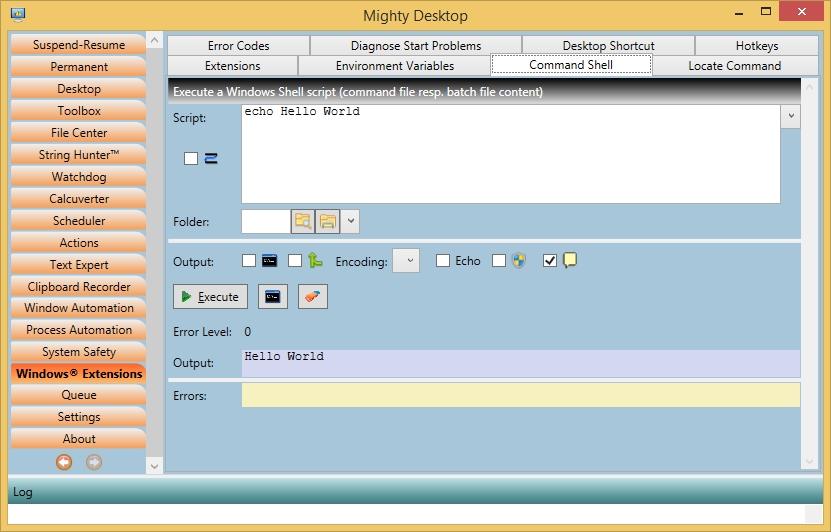|
This seems nothing special since Windows has its own built-in Command Shell and also a second, more modern version, the PowerShell. But for simple tasks PowerShell is slow at startup and more difficult to learn. The old DOS style Command Shell is quite lightweight and good enough for nearly all daily tasks. I really like to keep working with it, but with improvements appropriate to the year 2021.

Mighty Desktop's Command Shell in the 'Windows™ Extensions' tab provides this:
- Long lines can be displayed either as horizontally scrollable or wrapped around at the border of the window
- Text is edited in a better readable proportional font
- Normal text editing with the mouse is supported, also when wrapped
- Easy Copy&Paste with Ctrl-C, Ctrl-X and Ctrl-V, also for multiple lines
- Right-click-popup to explore a pathname
- Insert a file or folder path by dialog
- Unlimited undos which are kept even over the ending of the app
- Drag&Drop inside and from/to outside. Special support for dragging of one or more file system items into the box (automatic quoting and blanking between)
- Separate input box for the working directory in which the script should be executed, equipped with a history dropdown
- Choice of running the script as user or administrator
- Placeholders are supported inside the script (see Mighty Actions)
- Errorlevel permanently visible
- Standard and Error Channel either in separate fields or mixed, easy to copy out especially when wrapped
- Choice whether the script should be executed in an standard command shell window or directly in Mighty Desktop
- Choice whether the executed commands should appear in the output or not (ECHO ON/OFF by checkbox)
- Choice whether a pause should be done at the end of the run to view the output (PAUSE checkbox)
- No character set problems in any form because the character set can be chosen
- No arbitrary line splits at the right border of the output window
- Can be executed at any desired time and also repeatedly, using the Mighty Command Shell Script Command
- A history of all executed scripts including all the settings is saved even over the ending of the app. A reuse is a matter of two clicks. With the Windows command prompt, unfortunately, you lose that as soon as you close it.
- Execution is interruptible by stop button or Ctrl-Break even if the script itself doesn't check for it
- Button for starting a common Windows Command Shell in the selected folder.
Especially if you are experimenting with arguments for a command line program, you should remember this tab.
Notes:
- If a line has '^' at the end, the line below is appended at the end of this line for the execution. This allows you to spread long command lines over several lines of text to make them easier readable.
- If a program requests input you can click on the output field and press keys. But be warned that some prompts abort the execution if they see that they are not executed by a Windows command shell. In these cases it helps to switch the checkbox 'Window' on.
|